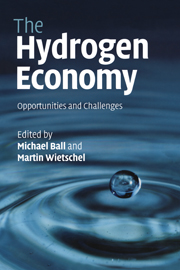Book contents
- Frontmatter
- Contents
- List of main contributors
- Preface
- Acknowledgements
- List of abbreviations
- 1 Scope of the book
- 2 Why hydrogen?
- 3 Non-renewable energy resources: fossil fuels – supply and future availability
- 4 Non-renewable energy resources: nuclear fuels
- 5 Assessment of the potentials for renewable energy sources
- 6 Carbon capture and storage
- 7 Energy-chain analysis of hydrogen and its competing alternative fuels for transport
- 8 Hydrogen today
- 9 Fundamental properties of hydrogen
- 10 Hydrogen production
- 11 Hydrogen storage
- 12 Hydrogen distribution
- 13 Key role of fuel cells
- 14 Hydrogen-infrastructure build-up in Europe
- 15 Building a hydrogen infrastructure in the USA
- 16 Hydrogen and the electricity sector
- 17 Hydrogen corridors
- 18 Macroeconomic impacts of hydrogen
- 19 Sustainable transport visions: the role of hydrogen and fuel-cell vehicle technologies
- 20 Energy-efficient solutions needed – paving the way for hydrogen
- 21 The future of hydrogen – opportunities and challenges
- Further reading
- Index
- References
8 - Hydrogen today
Published online by Cambridge University Press: 22 January 2010
- Frontmatter
- Contents
- List of main contributors
- Preface
- Acknowledgements
- List of abbreviations
- 1 Scope of the book
- 2 Why hydrogen?
- 3 Non-renewable energy resources: fossil fuels – supply and future availability
- 4 Non-renewable energy resources: nuclear fuels
- 5 Assessment of the potentials for renewable energy sources
- 6 Carbon capture and storage
- 7 Energy-chain analysis of hydrogen and its competing alternative fuels for transport
- 8 Hydrogen today
- 9 Fundamental properties of hydrogen
- 10 Hydrogen production
- 11 Hydrogen storage
- 12 Hydrogen distribution
- 13 Key role of fuel cells
- 14 Hydrogen-infrastructure build-up in Europe
- 15 Building a hydrogen infrastructure in the USA
- 16 Hydrogen and the electricity sector
- 17 Hydrogen corridors
- 18 Macroeconomic impacts of hydrogen
- 19 Sustainable transport visions: the role of hydrogen and fuel-cell vehicle technologies
- 20 Energy-efficient solutions needed – paving the way for hydrogen
- 21 The future of hydrogen – opportunities and challenges
- Further reading
- Index
- References
Summary
Worldwide, the number of attempts and efforts to develop and test hydrogen-related technology in vehicles and implement the necessary hydrogen supply infrastructure has been increasing tremendously in recent years, resulting in numerous hydrogen demonstration and lighthouse projects around the globe. In this chapter, first a brief summary of this development is presented, while recognising that this can only be a snapshot, as development is very quick and the information provided here can rapidly become outdated. Next, international roadmapping activities that show possible developments towards the introduction of hydrogen are described. Finally, the issue of social acceptance of hydrogen technology and the need for regulations and standards, are briefly discussed, since these are important factors for the hydrogen penetration and infrastructure transition process.
Hydrogen in the transport sector
With a share of more than 80% in total energy use in the transport sector, the automotive sector is the driving force for the introduction of hydrogen as fuel. Hence, the focus of hydrogen-vehicle manufacturing is on passenger cars and buses. Heavy-goods vehicles are not in the spotlight, as neither fuel cells nor hydrogen combustion engines are likely to manage a breakthrough in this market segment any time soon, because of the dominance and high performance of the diesel engines for long-transport applications.
- Type
- Chapter
- Information
- The Hydrogen EconomyOpportunities and Challenges, pp. 254 - 270Publisher: Cambridge University PressPrint publication year: 2009
References
- 5
- Cited by



